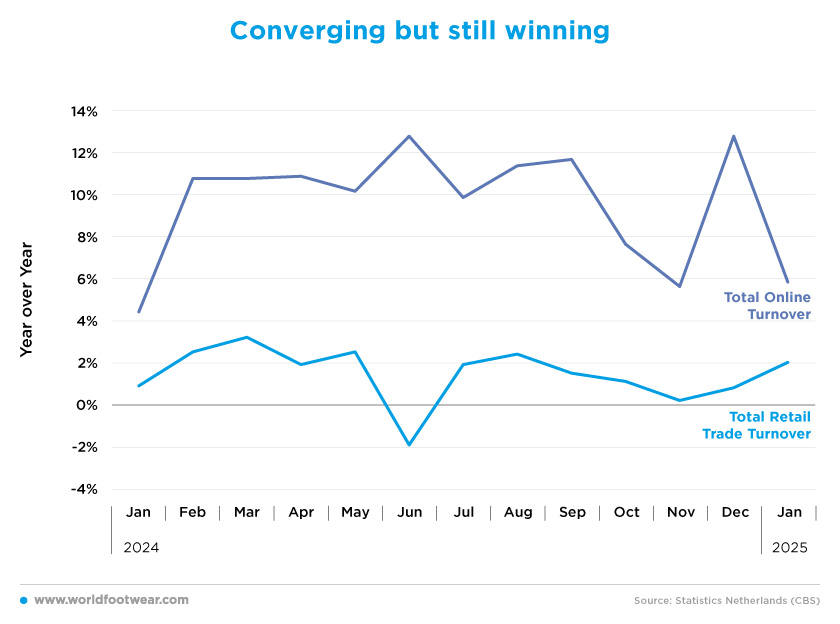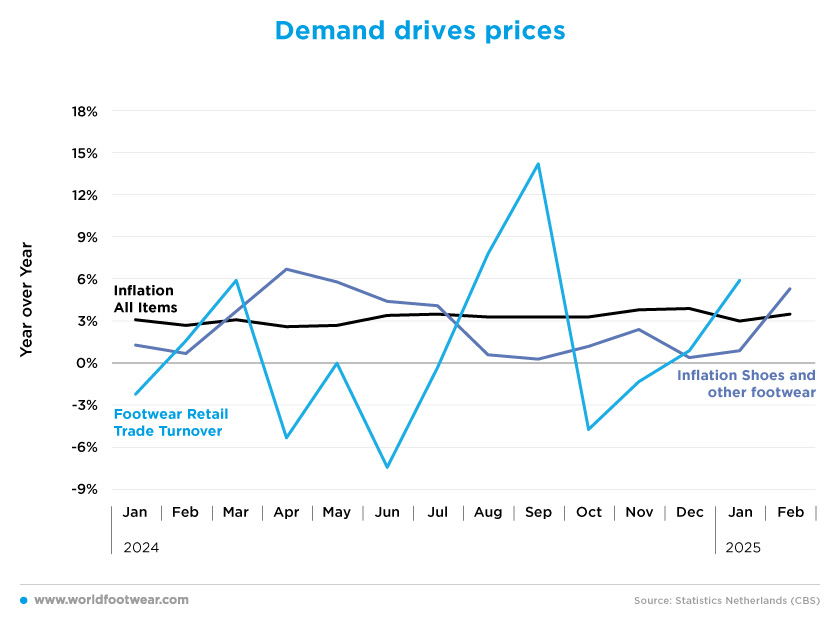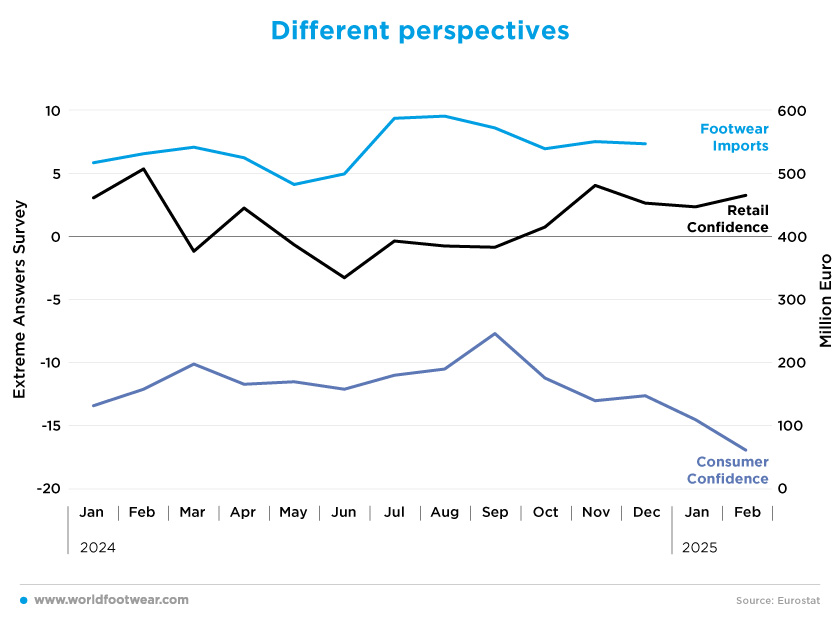Register to continue reading for free
Netherlands Retail: optimism reigns at the start of the year

Despite falling consumer confidence in the Netherlands, footwear retailers have good reason to be optimistic about 2025. The data shows that consumers have absorbed the expected lower price increases – footwear inflation shows no signs of abating – and will be spending. In fact, overall retail and e-commerce sales in the Netherlands are forecast to grow by 3.5% and 8%, respectively, this year. It’s worth noting that online shopping continues to stand out as a preferred channel for Dutch shoppers
Another hill coming up
Economic growth in the Netherlands will be stronger than previously expected this year and consumer spending should rise by around 2.5% this year and next, the government’s chief economic adviser said (reuters.com). And the fact is that retail sales are heading in the same direction.After the huge drop in footwear sales in October 2024 (where sales were down by 4.7% year-over-year), retailers began to see some light at the end of the tunnel. The first month of 2025 brought an increase in sales of 5.9%, as compared to the previous year (it should be noted that in January 2024, footwear sales recorded a decrease of 2.2%).
But in reality, footwear sales have been following the overall pattern of retail sales since November 2024, and the previous decline was probably just a correction after the considerable hill we saw in the summer months.
Several segments contributed to the growth in total retail sales (up by 2% year-over-year), including footwear and leather goods retailers. Footwear and clothing are in the green (up by 5.9% and 4% year-over-year respectively), so now the question is whether footwear retailers will repeat last year’s challenging first quarter.

Converging but still winning
For some time now, the Dutch are becoming increasingly fond of online shopping, and the figures confirm this trend. Dutch online marketplace Bol, for example, had a good year, with sales up by 8.7% to 3.1 billion euros. It also earned more from sales on its own platform than all its sales partners put together, the figures show. Bol seems to be becoming more of an online shop again, rather than a platform (ecommercenews.nl).Although retail sales have been growing over the last 12 months (except for June 2024), this isn’t comparable to the figures for e-commerce. In 2024, e-commerce sales recorded double-digit growth rates in 9 months (the highest being December 2024 at 12.7% y-o-y), which were around 4 to 5 times higher than retail sales growth rates.
“People are increasingly buying from the large web shops instead of going to many smaller web shops,” PostNL CEO Herna Verhagen recently said about the development of Dutch parcel volumes (ecommercenews.nl).
In the first month of 2024, things seem to be starting to converge, with online sales growing by only 5.8% and retail sales growing by 2%, as compared to January 2024. Pure online retailers – those whose primary business is online – led this growth with a 7.9% increase in sales. Multichannel retailers, which sell products both online and in physical stores, saw a more modest 1.0% increase in online sales, according to CBS (fibre2fashion.com).

Still, the reality is that online is still growing at almost three times the rate of retail sales.
Demand drives prices
The biggest retail price rises now seem to be behind us, although this does not mean all price rises are over (think.ing.com).Footwear inflation is on the rise again, with a rate of 5.3% in February, while overall inflation in the Dutch economy was 3.5%. All items inflation has been somewhat controlled over the past 12 months, as inflation in the Netherlands has eased by an average of 3.3% year-on-year, according to final figures from the Centraal Bureau voor de Statistiek (CBS) (nltimes.nl). However, it is proving to be an uphill battle to bring it back to the central bank’s 2% target.
In terms of footwear, the recent rise in inflation so far in the first two months of 2025 has been fairly correlated with increases in sales, as retailers increased their prices as the volume of footwear sales grew by around 5.9% in January. The same correlation occurred in the first quarter of 2024, with retailers responding to increased demand with small price increases – the only exceptions being the months of August and September, when price increases were close to zero, but sales increases were 7.8% and 14.2%, respectively.

Therefore, this year, prices are expected to rise at similar rates to last year (think.ing.com).
Different perspectives
Consumers and retailers have different views on the future of the Dutch economy.Retail Confidence has been positive since October 2024, rising by around 257% so far (from 0.7 to 3.2), but Consumer Confidence has shown the opposite trend, falling by 119% since September 2024. While it is difficult to fully understand all the factors influencing consumers’ economic assessments, beliefs about prices appear to be particularly important in explaining the recent low levels of confidence.
This is supported by European Commission and OECD surveys of European consumers, as well as ING Global Markets Research survey of Dutch consumers (think.ing.com).
The picture is certainly confusing, but retailers need to be prepared for any situation. The reality is that in 2024, Dutch retailers imported a total of 6.47 billion euros worth of footwear (equivalent to 366 million pairs of shoes), an increase of 13% compared to 2023. With this in mind, the rise in Retailer Confidence may indicate an increase in future imports, as retailers need to stock up regardless of consumer confidence.

Ultimately, retail and e-commerce sales in the Netherlands are forecast to grow by 3.5% and 8%, respectively, this year. With the loss of purchasing power now largely reversed and consumers more accustomed to higher prices, consumers are expected to loosen the reins a little this year and increase their spending both on the high street and online (think.ing.com).




